'He's quite a horse': Behind the rise, fall, and now rebirth of California Chrome
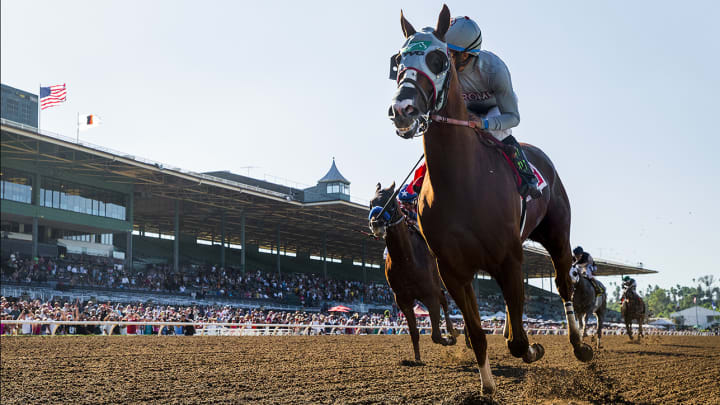
On the first Tuesday in July 2015, a thoroughbred racehorse named California Chrome was walked slowly off a long, white equine transport van and onto the backstretch at Arlington Park racetrack in suburban Chicago. Earlier that day, he had been flown from England, where he had spent the previous three months training. California Chrome did not look healthy; his chestnut coat was dull and spotty, and the skin on his flanks sagged across protruding ribs, with little muscle. His handlers would later estimate that he had lost at least 150 pounds from his 1,100-pound frame in four months. He walked gingerly, as if he were in pain (which, it turns out, he was). One year earlier, California Chrome had become the biggest star in racing, rising from modest beginnings to win the Kentucky Derby and the Preakness, before falling short of the Triple Crown with a fourth-place finish in the Belmont Stakes. Now he was an afterthought, just another of the many horses to fail to collect racing’s biggest prize before American Pharoah finally broke through in 2015. The sport had moved on, as sports will do.
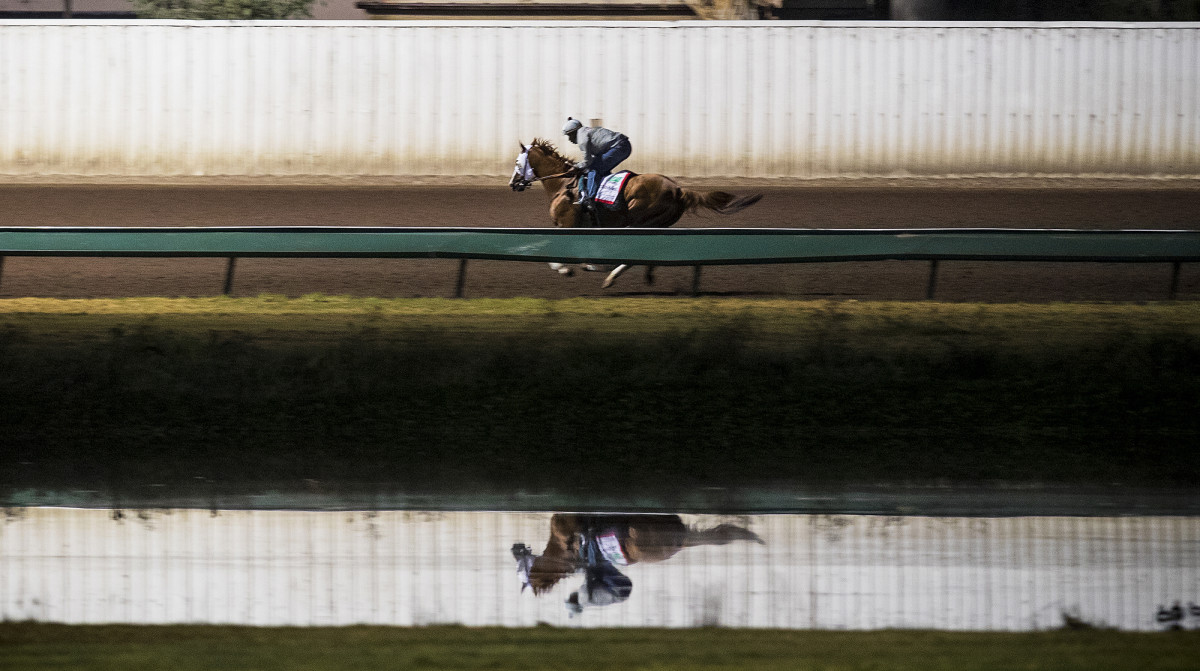
As photos of Chrome at Arlington Park buzzed across social media, the racing community and in particular Chrome’s passionate fans—they call themselves “Chromies”—were crestfallen. Racing fans are pigeonholed as soulless, numbers-crunching gamblers (and many of them are just that), but in truth some of them are drawn to the sport by a deep affection for the equine athlete that straddles the line between charming and excessive but is unquestionably real. They were outraged that a beautiful horse had been allowed to wither. The people closest to Chrome were most saddened. “He looked skinny, almost like he was anorexic,” says jockey Victor Espinoza, who rode Chrome to his Derby and Preakness victories and also guided American Pharoah to the Triple Crown. “I barely recognized him. He looked like he was in really, really bad shape. I thought, for sure, that was going to be the end of his career.”
Nearly 16 months have passed since that day, which improbably and emphatically was not the end of California Chrome’s racing career. Chrome, now five years old, has competed in six races since July 2015 and won all of them, accumulating more than $7.1 million in purse money for his human connections and running his career total to $13.4 million, the highest of any North American horse in history and very much within striking distance of the all-time leader, T M Opera O, who while running exclusively in Japan from 1999 through 2001 won $14.1 million in purses. On Saturday evening, California Chrome will be the favorite in the $6 million Breeders Cup Classic at Santa Anita Race Track in southern California. He has spent much of the last year stabled at Los Alamitos Racetrack, also in southern California, in the care of 79-year-old trainer Art Sherman, who was at the center of Chrome’s Triple Crown campaign, nearly lost him, and now has him back. Sherman rises most mornings at 4:45, drives to his barn and walks directly to Chrome’s stall and feeds him a cookie. “He’s quite a horse,” says Sherman. “But he’s my pet too.”
On clear mornings, when sunlight knifes low across the sky and douses the backstretch in a deep yellow glow, Chrome’s coat shimmers like a freshly minted copper penny. He is a healthy horse now, and a fast horse again, reborn. One of the fastest ever. “He stands at the front of his stall and sticks his head out,” says Espinoza. “He’s got all this muscle, and it’s like he’s saying, I’m the boss.”
The racetrack is a wonderland of dreamers, a place where money buys hope, but it is also a place for heartbreak, and where today is for getting rich and tomorrow is for getting even. It is a haven for the rich and the famous, but also a hornet’s nest of tricks and scams. Everyone is looking for a score. California Chrome is the ultimate score. Twice over. He walks the earth because two racetrack rookies bought a slow-footed, skittish mare for $8,000, watched her fail on the track and bred her to an unproven stallion for $1,500, which is about as little as one can pay for such a transaction. The resulting colt should not have been fast, durable or efficient, but California Chrome proved to be all of these things and won the first two legs of the Triple Crown. He was arguably the most popular racehorse in America since Smarty Jones won the Derby and the Preakness in 2004.
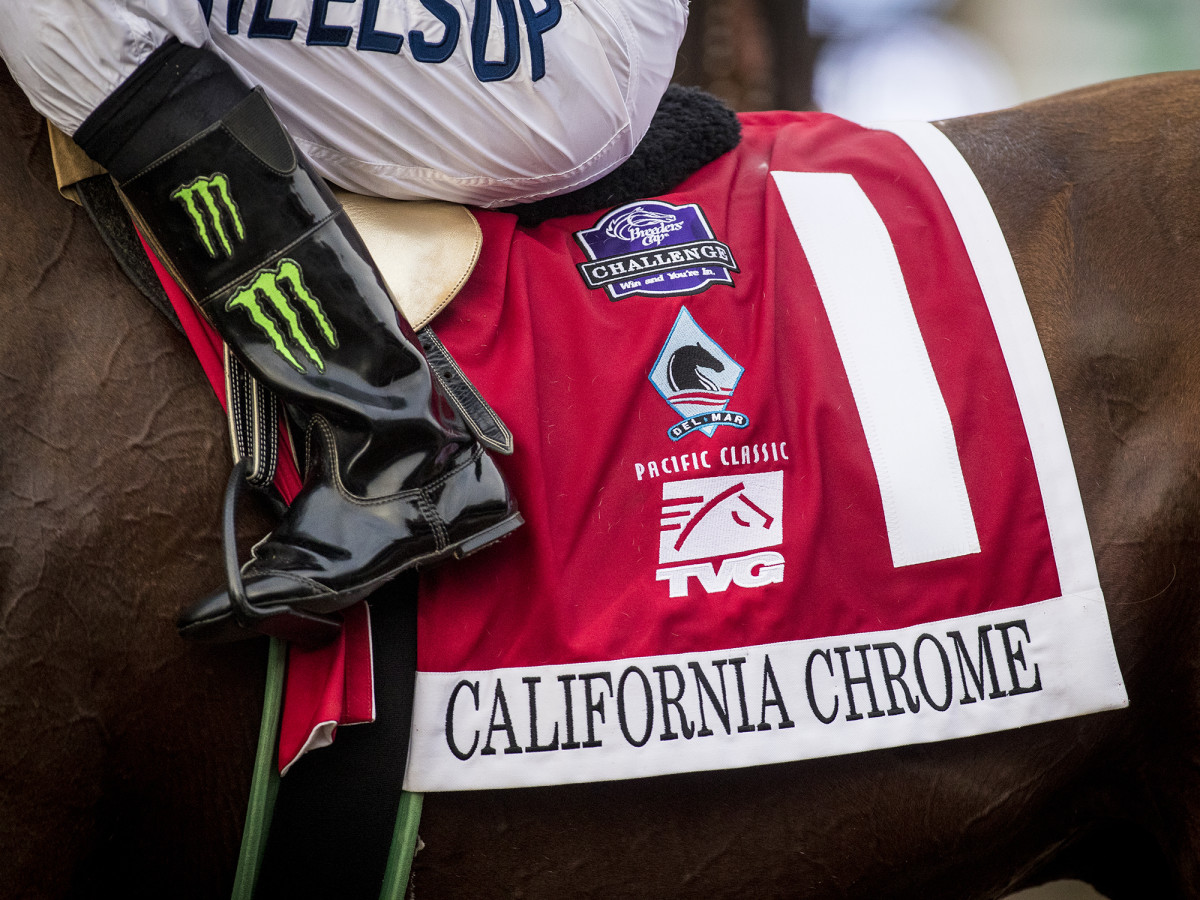
Chrome’s karma went south when, in the wake of his Belmont defeat, minority owner Steve Coburn, in his white cowboy hat, unleashed a post-race rant in which he called the connections of winning horse Tonalist “cowards” for skipping the first two legs of the Triple Crown series. Chrome lost four of his next five races, culminating in a second-place finish the following March in the Dubai World Cup, a defeat that came with a $2 million consolation prize. Majority owner Perry Martin, against the wishes of Sherman and Coburn, ordered that Chrome be shipped to England to prep for turf races that he never was healthy enough to run, and at last, to Chicago, bedraggled and unfit, seemingly finished.
His revival is a story of inquisitive veterinary science, creative economics and stunning equine resiliency. Chrome has not only broken purse records, but he also has pushed his potential stud fee to a range once thought impossible, given his very modest pedigree. A breeding farm has been made to look very smart, owner-investors have been enriched for their faith, racing has been gifted the rare star older than age three. And the man in the cowboy hat watches from afar, his heart still in the game, but broken.
Every horse is for sale—it’s a credo of the racing game. When California Chrome started reeling off victories in the winter and early spring of 2014, wealthy people lined up, checkbooks in hand. Coburn and Martin were the owners, men who had not known one another but in 2009 had invested in a syndicate that bought a mare named Love The Chase. After the syndicate’s manager decided to get rid of Love The Chase by entering her in $8,000 claiming races, Coburn and Martin bought her outright—Martin in for 70% and Coburn for 30%. A backstretch groom mumbled that anyone who would pay eight grand for Love The Chase was a “dumb ass,” so Martin and Coburn named their nascent operation Dumb Ass Partners, shortened to DAP on their whimsical racing silks. They were a mismatched pair, Coburn loud and freewheeling, a factory worker in a white Stetson and battered boots; Martin, measured and distant, claiming multiple college degrees, the owner of a product testing lab. Theirs was a marriage of convenience, doomed to end in a messy divorce.
Yet in that spring of 2014, they agreed not to sell Chrome to a bidder who first offered $6 million and then, two hours later, $6 million for a 51% share and full control. At the time Coburn told me, “What price can you put on a dream?” And Martin: “But I also think people are low-balling us just to do a deal with two guys who supposedly don't have any money. At least I keep hearing that’s what we are.”
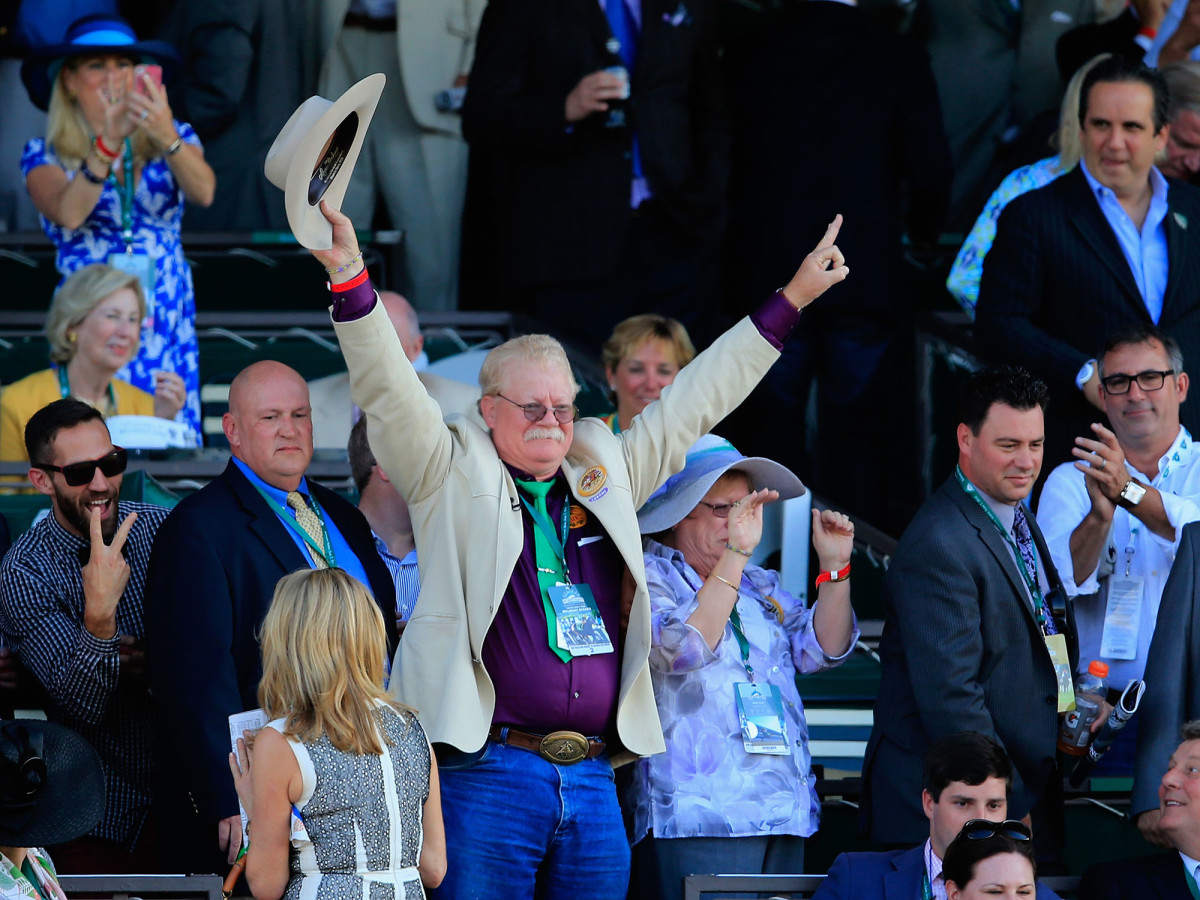
The relationship slowly unraveled. After Coburn took the occasion of the Preakness victory ceremony to criticize the hospitality at the Kentucky Derby, Martin called Churchill Downs officials to apologize. When Coburn unloaded after the Belmont, Martin distanced himself. In the spring of 2015, when Martin sent Chrome from Dubai to England to run those two turf races (in theory, to increase his stallion value), Coburn objected (as did Sherman). In an April 2015 interview for an SI.com story, Martin told me, “Steve is my compass. Whatever he suggests, that means I go 180 degrees the other way.”
Those words have stung Coburn to this day. “When he said that about me, I knew no matter what I said, it wasn’t going to matter. I was the minority partner. But he let people know he was going to take control. The partnership had pretty much gone to hell.”
Coburn’s wife, Carolyn, who introduced Steve to the racing game and had tried desperately to pull him away from media during his post-Belmont rant, saw no option but to sell the couple’s share of Chrome. “I told Steve, ‘We can’t go on like this,’” recalls Carolyn. “Perry made it clear that he was going to do whatever he wanted to do. So we did what was best for Chrome and what was best for our peace of mind. We never wanted to sell Chrome. But there was turmoil in our life.”
The Coburns’ pain would become somebody else’s opportunity. Duncan Taylor, the president and CEO of Taylor Made Farm, a 40-year-old family-run Kentucky breeding operation, had asked Martin and Coburn in January 2015 about buying California Chrome for the purpose of standing him as a stallion. But their asking price was too high. As Chrome struggled in England and news of the disharmony between Martin and Coburn went public, Taylor made another run. This time Coburn agreed to sell his 30% share for approximately $2.25 million. Martin kept his 70% stake, but he agreed that as part of the purchase, Chrome would stand at Taylor Made when his racing career was over. Also, Taylor Made was given latitude to unilaterally retire Chrome; any decision to continue racing would be made in conjunction with Martin. (This information was provided to SI.com by Taylor; Martin did not respond to multiple text and voice messages).
“At that point,” says Taylor, “we were thinking about just retiring him.”
Before the sale could be finalized, a physical examination was scheduled. Dr. Larry Bramlage, Taylor Made’s consulting veterinarian, asked Arlington-based vet Dr. James Gilman to handle the exam. Because of the high stakes, Taylor and at least six other partners and investors watched Gilman do his work. Chrome had been treated in England for what was diagnosed as a foot problem, but Gilman almost immediately suspected that a different issue was in play. “I could see that the horse was uncomfortable,” he says. “He had a lameness that’s not related to his feet.” Gilman did X-rays of Chrome’s lower extremities and found what he describes as “inflammatory bone disease” in all four ankles, a condition that was more pronounced in the forelegs.
Inflammatory bone disease—often simplified to bone edema or bone bruising—occurs where the cannon (the long bone below a horse’s knee) meets the fetlock (ankle) and is caused by pressure and swelling at the bottom of the bone. It is most common in horses actively involved in a rigorous training and racing regimen. In such horses, bone growth takes place in the lower legs to accommodate stress, a protective function in which the body fortifies its own armor. The new growth requires increased blood flow for nutrition, but a horse in training is poorly positioned to meet these needs.
“Horses have relatively poor blood supply to their lower limbs,” Bramlage says. “This is why they evolved as a grazing animal. If you watch a horse eat grass, he doesn’t eat in a 20-meter circle, he covers the entire field. Take three bites, walk three steps. Take three bites, walk three steps. They move around the field to pump blood to the lower part of their limbs. But when they are in heavy training to race, they are in their stalls 23 hours a day.”
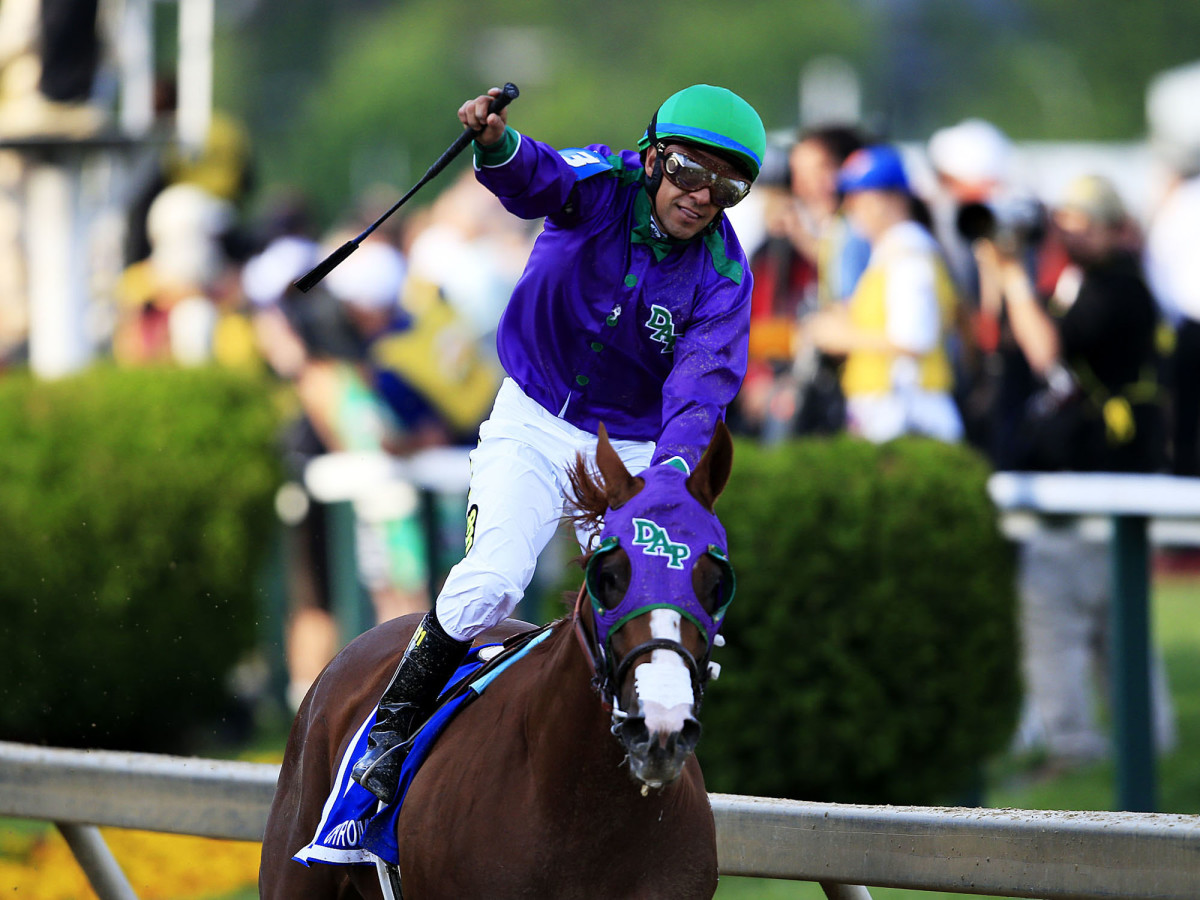
California Chrome was one of the most heavily raced and trained high-level thoroughbreds of recent equine generations. From his debut on April 26, 2013 through the Belmont Stakes on June 7, 2014, Chrome raced 13 times. More pointedly, he was given no significant rest. After the Belmont loss, Chrome was shut down for 105 days before finishing a dull sixth in the Pennsylvania Derby in September. That began a run of five races in sixth months, ending with the Dubai race of 2015. “He was a tired horse,” says Alan Sherman, Art’s son and assistant trainer. “That was a hard three-year-old campaign.” Durability was part of Chrome’s appeal. After his easy win in the Preakness, I interviewed Shim Liberman, supervising veterinarian at the Pimlico detention barn, where Chrome cooled out after the race. Liberman raved at Chrome’s swift recovery from a Triple Crown race, his second in two weeks. “All I can say,” he told me, “is that from what I saw at Pimlico, you’ve got to think they didn’t get to the bottom of the barrel.” This was the stuff of legend. In retrospect, Chrome most likely was slowly wearing down and never fully recovered from that three-year-old season.
A diagnosis of inflammatory bone disease can be challenging because afflicted horses will walk uncomfortably but will not display swollen, or “hot,” joints, shifting suspicion to the feet. According to Gilman, improved digital imaging developed over the last decade has made a more accurate diagnosis possible, and he estimates that inflammatory bone disease “is responsible for 80% of lameness in the racing thoroughbred.” Gilman has studied this disease for 15 years; it was Taylor Made’s good fortune that he did the initial exam.
In California Chrome’s case, Gilman and Bramlage concur that the inflammation and resulting pain were responsible for all of the horse’s issues. “He had lost a significant amount of weight and muscle mass,” says Gilman. “It’s all associated with pain, and that horse was in pain 24 hours a day.” (Martin had intended to run Chrome in the 2015 Arlington Million, an August turf race at Arlington Park; because of Chrome’s weakened condition, that was out of the question).
Next came some startling news. Gilman told Taylor and his team that the most effective treatment for the disease was to stop all racing and training and send California Chrome to a farm where he could roam in grassy paddocks for at least three months. “I told them that the horse could easily return to what he was as a racehorse, or even better,” says Gilman. Bramlage agreed: “Get him in a field, let him move around and exercise the way a horse was meant to exercise.”
This possibility of returning Chrome to the racetrack altered the economics of his future. Had Taylor put Chrome to work as a stallion, his stud fee would have been approximately $15,000. The stallion with the highest stud fee in North America is Tapit, at $300,000. American Pharoah, the 2015 Triple Crown winner, stands for $200,000. (Stud fees are a function of pedigree, racetrack performance, physical appearance and a fourth, almost immeasurable quality, i.e., how “hot” the horse is). By the summer of 2015, California Chrome had a relatively weak pedigree in his first generation (although better beyond that), a solid racing record, an excellent physical appearance and a terrible vibe. “With California Chrome’s pedigree, it was always going to be difficult to make huge money,” says pedigree expert Sid Fernando, who advises many racing operations on breeding decisions. “At that point, he was also coming off a lot of bad publicity from the Belmont, and poor management.”
Breeding arithmetic is fairly straightforward. At $15,000 per live foal, and roughly 135-150 matings, Chrome could earn somewhere between $2.025 million and $2.25 million in his first year at stud. (For comparison, American Pharoah can generate up to $30 million). Victory in the Dubai World Cup was worth $6 million, and second place was $2 million. It is uncommon for a breeding farm to purchase a horse with the intent to stand him as a stallion and then send him back to the racetrack, but that is what Taylor Made, in concert with Martin, did. “We looked at it, and saw that he could potentially make more money in one race than in an entire season of breeding,” says Taylor. “That’s not something our company normally does, but thankfully, we did it this time.” (California Chrome would eventually win that 2016 Dubai race, and its $6 million purse).
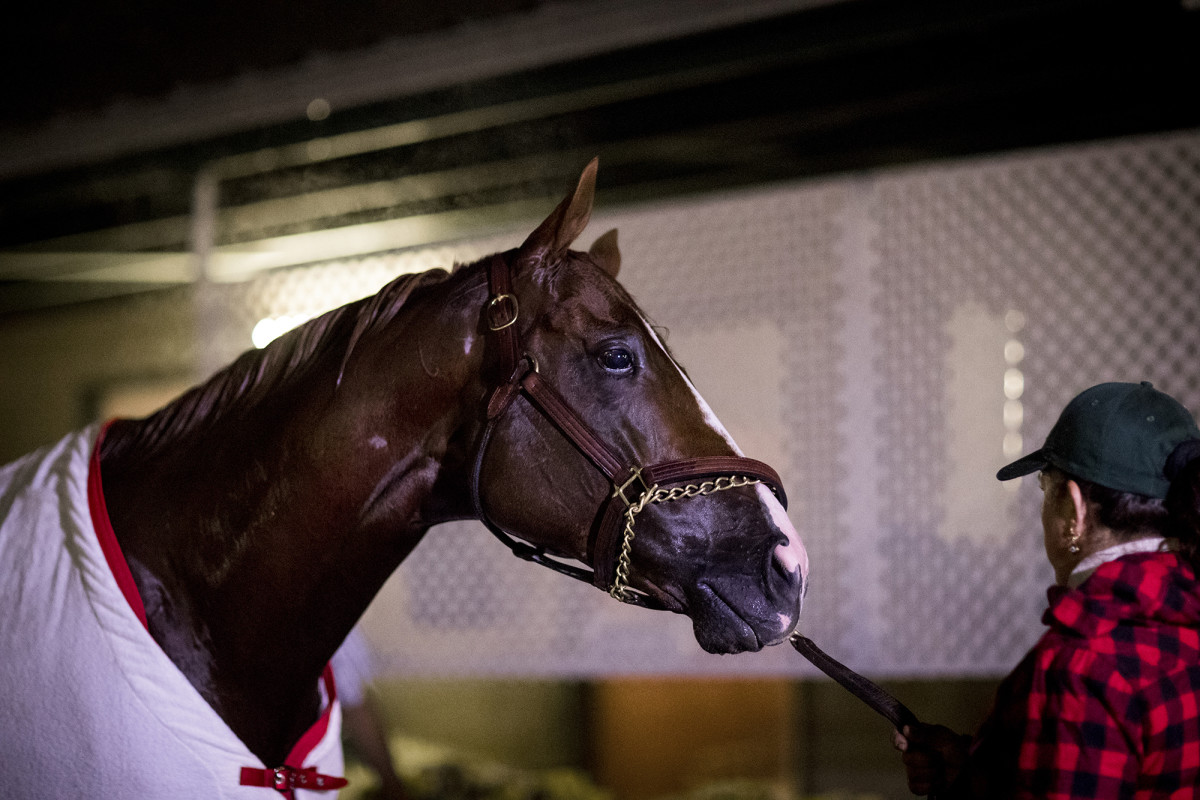
Chrome was then moved to a stallion paddock at Taylor Made. According to stallion manager Gilberto Terrazas, he was given a 10-day course of Butazolidin, a nonsteroidal anti-inflammatory drug, and then placed on a longer-course aspirin to assist in circulation. But mostly he was allowed to run loose in a field. “For about a month, he was kind of depressed,” says Terrazas. “But then he started to come out of it.” Bramlage fended off inquiries about putting Chrome back in training. “[Taylor Made] wanted to return him to training as soon as possible,” says Bramlage. “We had to hold him back until we were certain he was over the hump.”
Seven months after the race in Dubai, in late October 2015, Taylor Made and Martin sent Chrome back to Sherman, with a plan to take his schedule one race at a time. They also began selling shares of the horse—each share valued at 2%. The first shares where sold at $150,000 and now are priced at $425,000. For one share, an investor gets 2% of Chrome’s race earnings, the opportunity to breed one mare and 2% of an “overage pool.” (An overage pool refers to available breeding rights after contracted rights are accounted for, to reach the total of 135-150 matings). With investors owning 50 shares and 10 others granted to individuals such as Art and Alan Sherman and Espinoza, the overage pool will be approximately 60 breeding rights.
Since this plan was formulated, California Chrome has won those six races and the $7.1 million in purses beginning with the victory in Dubai last March. Investors who paid $150,000 have recouped more than $140,000 in purses. Taylor Made has sold four shares, thereby retaining 22% ownership. According to Taylor, Martin has sold more than half of his 70% stake and describes Martin’s active holdings as a “moving target.” None of this is finished. The Breeders Cup Classic pays $3.3 million to the winner; second place is $1.2 million. Next January at Gulfstream Park, Chrome most likely will run in the inaugural $12 million Pegasus World Cup, another opportunity to add significantly to his purse total.
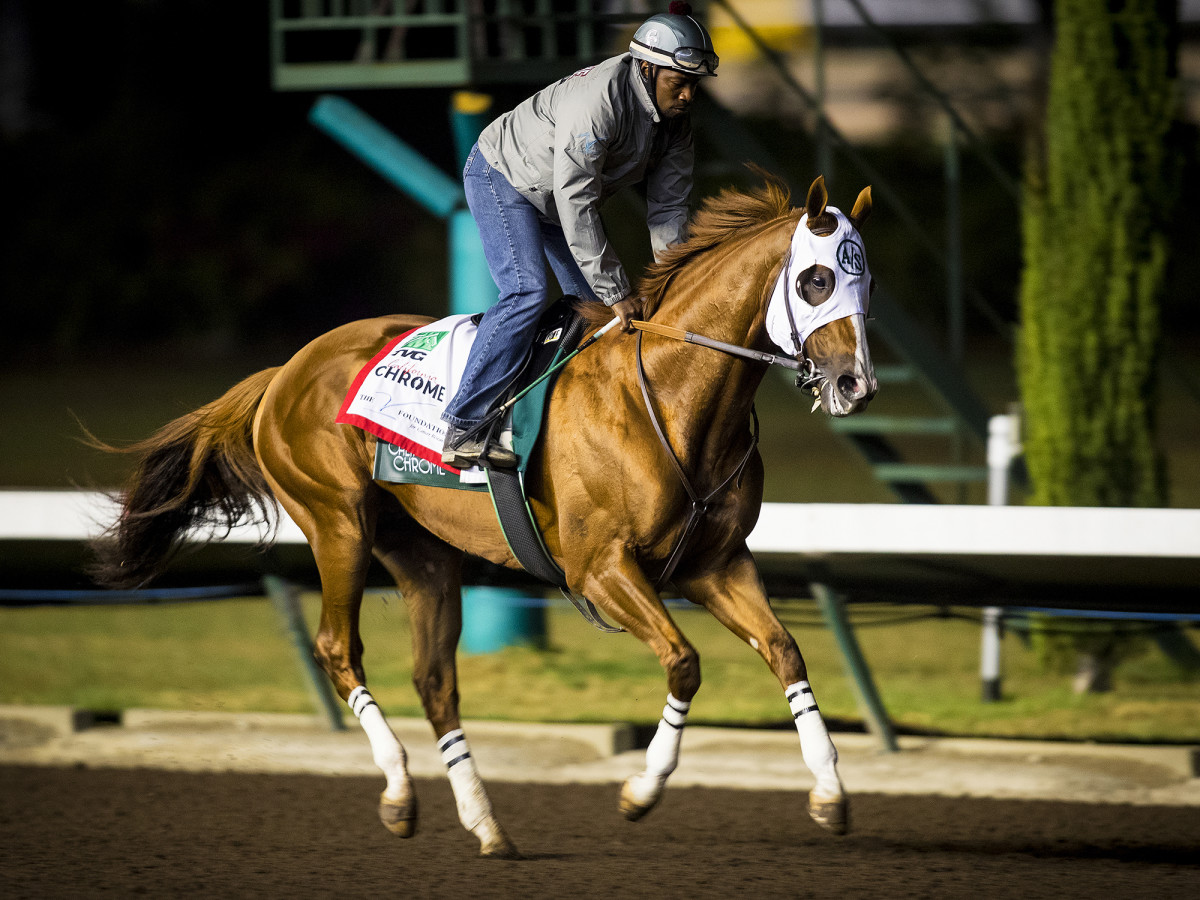
Moreover, all of this winning has increased Chrome’s value as a stallion. “Not only did Taylor Made make a huge amount of money by racing him,” says Fernando, “they raised his reputation to iconic status beyond the ‘Chromie’ realm of things. At this point, he’s considered a great racehorse, easily double the value of what he would have been as a stallion. It’s been an incredible success story.”
Taylor estimates that Chrome could now stand for as much as $50,000. (Fernando cites the cases of two-time Breeders Cup Classic winner Tiznow, who like Chrome was bred in California to very modest parents, but through a brilliant racing career and solid offspring, now stands for $60,000). “We’re not geniuses,” says Taylor. “We’re blessed that this horse has stayed sound. We could do it this way 10 more times, and it could go south nine times.”
There is a possibility that Chrome will run beyond the Pegasus World Cup; Taylor puts those chances at 5%. Take, for example, the Dubai World Cup and the $6 million it awards to the winner. “If Sheikh Muhammad were to raise that six million to eight million,” says Taylor, “that’s where the 5% might come into play.’’ After all, even with a $50,000 stud fee, covering 150 mares would only generate $7.5 million. Says Taylor, “It is an economic decision. But we’re going to put the horse first. If there’s anything wrong with the horse, we will send him to stud.”
Over the last three years, Victor Espinoza, a 44-year-old Mexican émigré, has ridden two of the most popular and successful racehorses in modern American racing. First he nearly took Chrome to the Triple Crown. Then he finished the job on American Pharoah. Now he is back with Chrome, having broken earnings records. He likes to disarm inquisitors by calling himself “the luckiest Mexican,” but that’s a little bit of false modesty. He’s good, and he knows it. But there’s also a little truth. In the winter of 2013, when Sherman, Martin and Coburn removed Alberto Delgado from Chrome, their first choice was Mike Smith. He declined. (“Remember,” Smith told me on the day of the 2014 Belmont, “he wasn’t California Chrome back then.”) And trainer Bob Baffert approached at least four other riders for American Pharoah before giving Espinoza the mount.
The 2014 Belmont still haunts him. Chrome had always been sharp, but on that day he was not. The post-race story line—besides Coburn’s unseemly rant—was that Chrome had been stepped on while leaving the gate, bloodying his hoof. Nevertheless, he rallied to finish fourth, beaten only by 1¾ lengths for first. Espinoza says there was more to it. “He wasn’t 100%,” the jockey says. “I got on him in the paddock, and it was the worst feeling in the world. He wasn’t happy; he didn’t have that energy. He got his foot stepped on because he didn’t have any energy, and he broke in slow motion. But he ran hard. I was proud of him.”
When Espinoza climbed back on Chrome last March for the Dubai World Cup, he felt a different animal. Bigger, older, stronger. As a three-year-old, Chrome needed to run free in the middle of the track; if pinned on the rail, he would shrink. No longer. In the Oct. 1 Awesome Again Stakes at Santa Anita Race Track, jockey Rafael Bejarano used four-year-old Dortmund to pressure California Chrome down the backstretch, yet Chrome jogged away coming home. Espinoza never raised his whip, just as he had never touched Chrome seven weeks earlier in an easy victory over highly regarded mare Beholder in the Pacific Classic.
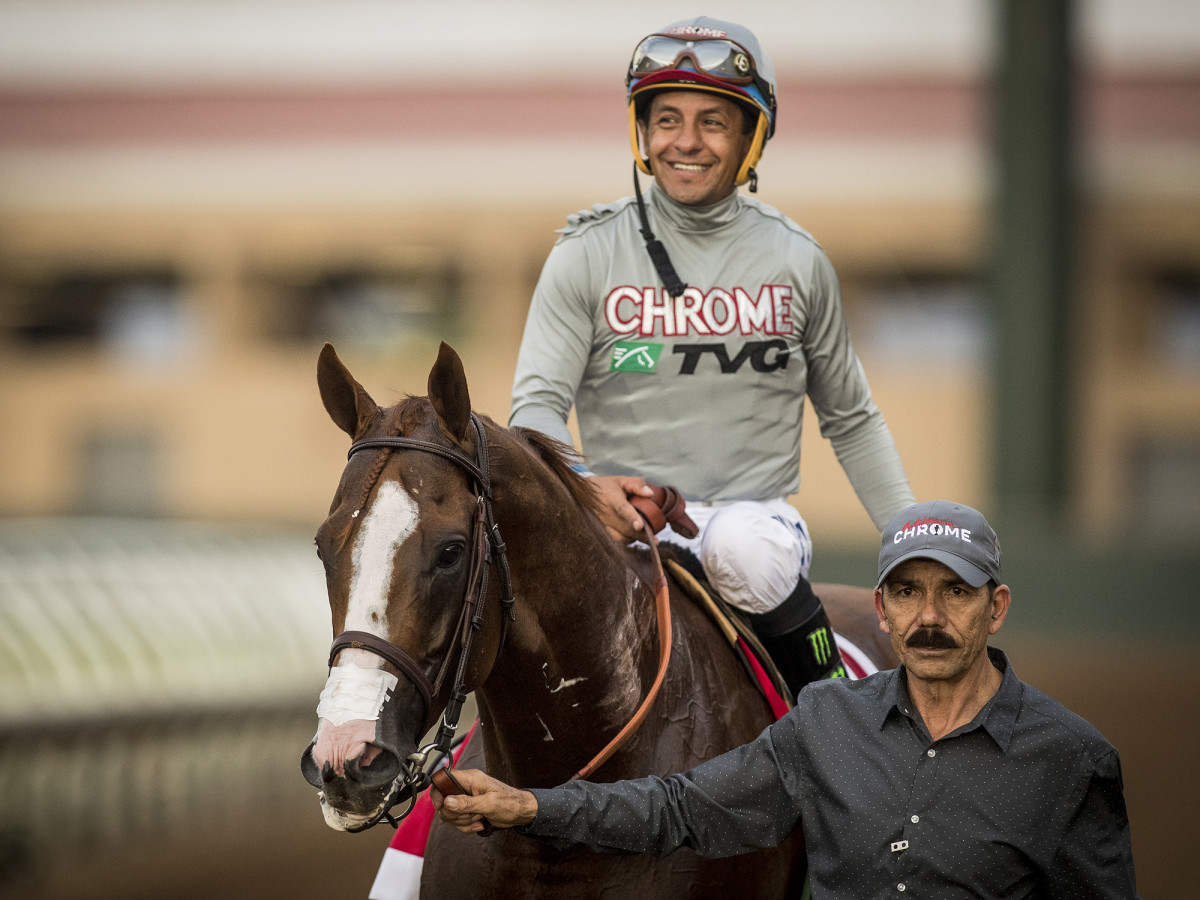
Not a day passes that Espinoza isn’t asked to compare Chrome to Pharoah. It’s an awkward question. Chrome was an outstanding three-year-old, but Pharoah won the Triple Crown, and spectacularly. The drought between Triple Crown winners had stretched to Affirmed in 1978, and Pharoah’s Belmont victory was the most significant moment in American racing since Secretariat won in ’73. But racing can’t live by the Triple Crown alone. The sport needs older horses to sate its fan base, and Chrome has been a remarkable five-year-old. Also, it’s unfair to compare a three-year-old horse, the equivalent of a human teenager, to a five-year-old, a fully mature adult.
Ahmed Zayat, who owned American Pharoah during his racing career, and who is prone to emotional statements on the horse’s behalf, became angry recently when he was told that Espinoza had said that Chrome was the better horse. (Espinoza denies making the statement.) In response, Zayat told Bob Ehalt for an article posted on the website Thoroughbred Racing Commentary, “I believe they don’t breathe the same air.” In a text message last week, a becalmed Zayat said, “Who really cares what I think of California Chrome? I’m just in love with my horse and all stars, and of course California Chrome is a real star.”
Espinoza undoubtedly has a special affection for Chrome. “We’ve been through so much together, for a long time, ups and downs,” he says. “California Chrome, he’s my boy. I’ve spent more time with him than I did with American Pharoah. More races, more mornings. But they’re both incredible animals.”
Pressed, he begins handicapping. “It’s different, the way the two of them run,” says Espinoza. “American Pharoah, he had this powerful speed. Nobody could keep up with him. California Chrome, he’s quick. He makes that move in the stretch and opens up three or four lengths. If they raced, I think American Pharoah would be in the lead, and California Chrome would be right next to him and then he would make his move on the turn and we’ll see who wins.”
And? “That’s the best part,” says Espinoza, laughing in his distinctive, high-pitched giggle. “I don’t have to pick.” So, this again: “I’m the luckiest Mexican.”
There are many happy people in the California Chrome story. The trainer. The owners. The jockey. The investors. But because this is racetrack prose, there must also be sadness. In 2014, when California Chrome was en route to becoming one of the unlikeliest Kentucky Derby winners, Steve Coburn was the face—and the voice—of the horse. He was brash and loud and fun, and America loved him until he went off the rails in the gloaming at Belmont Park.
The Kentucky Derby and the Triple Crown chase make public figures of private citizens, most of whom aren’t prepared for the fame. Coburn brought a big heart and a big mouth to the trail, and it only seemed a matter of time until he embarrassed himself. He is retired now, living above 5,000 feet, surrounded by ski areas near Topaz Lake in Nevada. He knows he made an irreversible mistake that day in New York. “If I could go back,” says Coburn, “I’d say I’d just like to congratulate the connections of Tonalist on a race well-run, and then leave it at that. But I didn’t do that, and so…” His voice trails off.
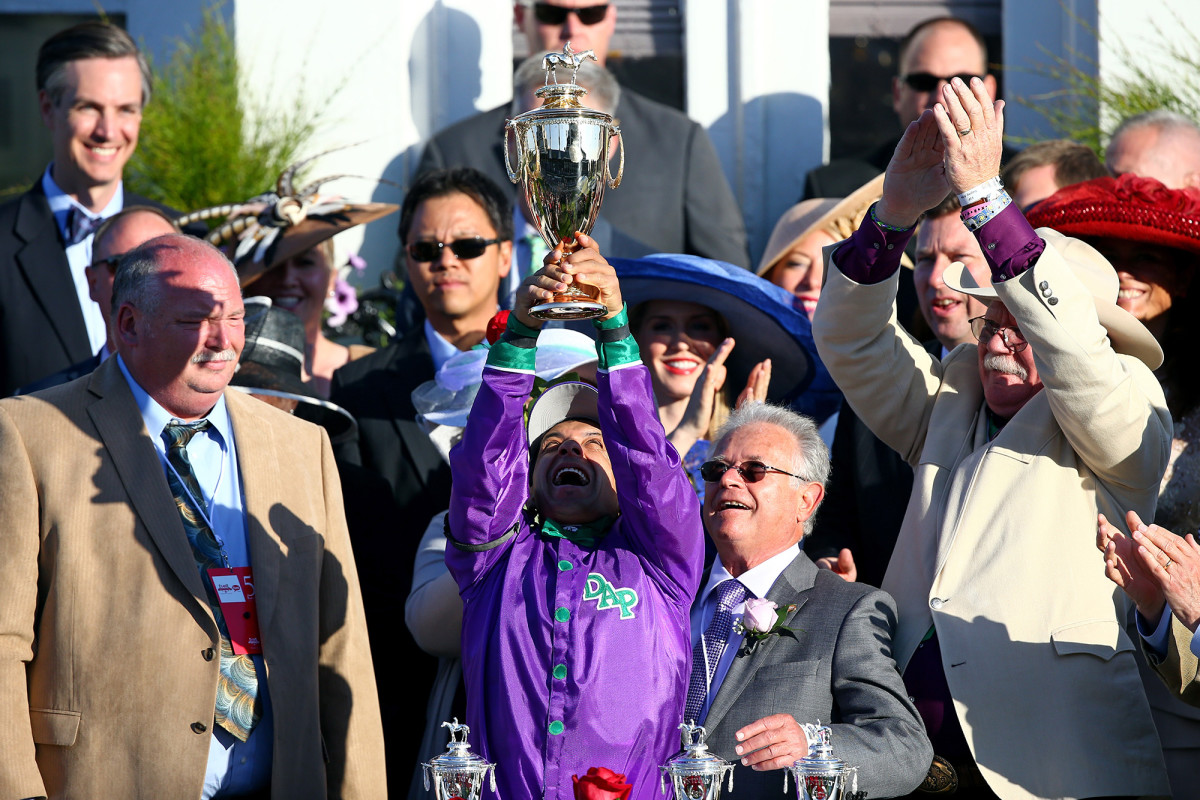
There are good memories. The races, the lifelong friends made. When he’s asked about selling Chrome, Coburn says, “It’s tough on me. That horse was a part of our lives. I still love him.” He pauses. “These things are hard for me to talk about.” The Coburns visited Chrome at Los Alamitos, and Taylor Made Farm officials have told the couple they are welcome to visit the horse any time; Art Sherman has said the same. But, of course, it’s not quite the same as being an owner.
“We thought we would always have him,” says Carolyn Coburn. “We thought we would have him in retirement and he would go to stud and we’d visit him all the time. And there would be income coming in. It didn’t work out that way. But I’ll tell you, when we see him, Steve calls his name and Chrome starts whinnying and comes up to Steve, and they’re still the best of buddies. Except for a piece of paper that says we don’t own him, he’s still our horse. Nothing can ever change that.”
The Coburns have started their own stable, called Silver State Racing. Their only horse is a two-year-old filly named R Sunday Surprise. Her parents are the same as California Chrome’s: the slow mare Love The Chase and the cheap stallion Lucky Pulpit, who gave the very best of themselves to Chrome, a genetic jackpot. The California Chrome story is told most eloquently in R Sunday Surprise’s racing line: third, fifth, third and, most recently, ninth. She is the reality of a hard game. He is a fairy tale, told twice.
